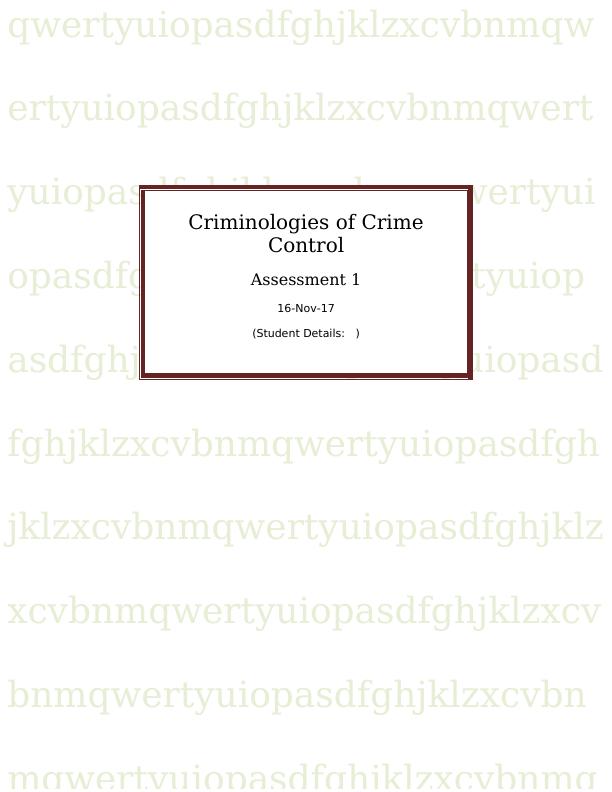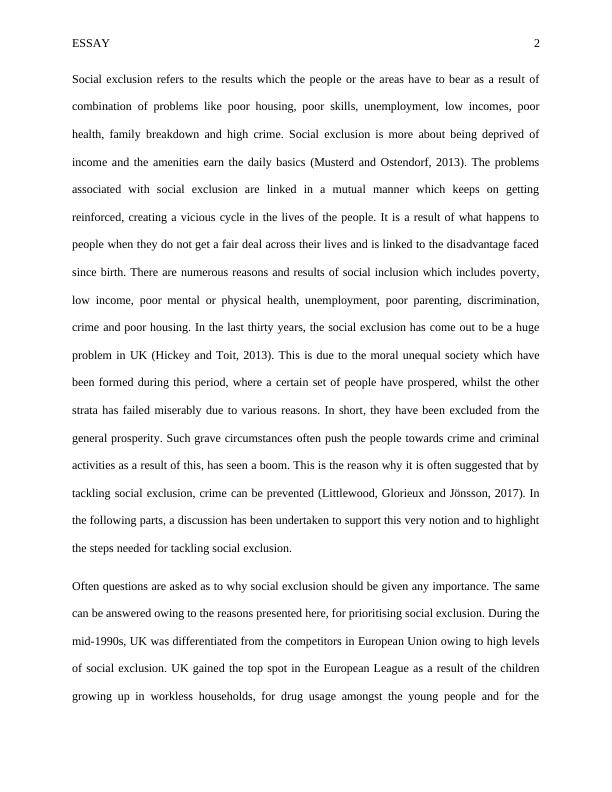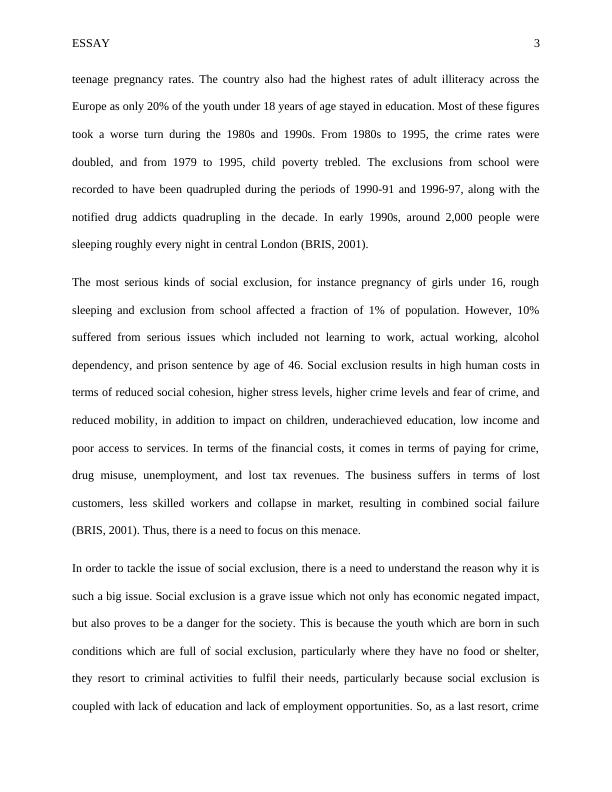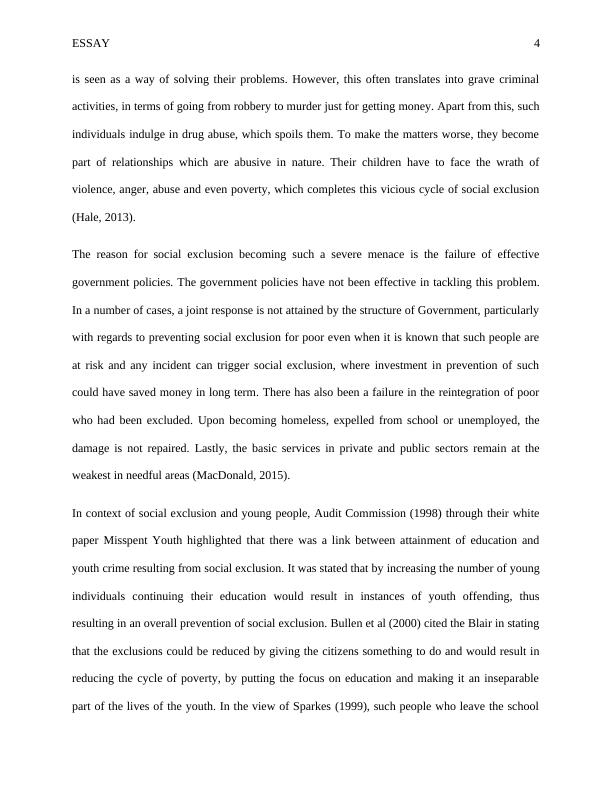Criminologies of Crime Control Assessment
11 Pages3185 Words30 Views
Added on 2020-04-13
Criminologies of Crime Control Assessment
Added on 2020-04-13
ShareRelated Documents
qwertyuiopasdfghjklzxcvbnmqw
ertyuiopasdfghjklzxcvbnmqwert
yuiopasdfghjklzxcvbnmqwertyui
opasdfghjklzxcvbnmqwertyuiop
asdfghjklzxcvbnmqwertyuiopasd
fghjklzxcvbnmqwertyuiopasdfgh
jklzxcvbnmqwertyuiopasdfghjklz
xcvbnmqwertyuiopasdfghjklzxcv
bnmqwertyuiopasdfghjklzxcvbn
mqwertyuiopasdfghjklzxcvbnmq
Criminologies of Crime
Control
Assessment 1
16-Nov-17
(Student Details: )
ertyuiopasdfghjklzxcvbnmqwert
yuiopasdfghjklzxcvbnmqwertyui
opasdfghjklzxcvbnmqwertyuiop
asdfghjklzxcvbnmqwertyuiopasd
fghjklzxcvbnmqwertyuiopasdfgh
jklzxcvbnmqwertyuiopasdfghjklz
xcvbnmqwertyuiopasdfghjklzxcv
bnmqwertyuiopasdfghjklzxcvbn
mqwertyuiopasdfghjklzxcvbnmq
Criminologies of Crime
Control
Assessment 1
16-Nov-17
(Student Details: )

ESSAY 2
Social exclusion refers to the results which the people or the areas have to bear as a result of
combination of problems like poor housing, poor skills, unemployment, low incomes, poor
health, family breakdown and high crime. Social exclusion is more about being deprived of
income and the amenities earn the daily basics (Musterd and Ostendorf, 2013). The problems
associated with social exclusion are linked in a mutual manner which keeps on getting
reinforced, creating a vicious cycle in the lives of the people. It is a result of what happens to
people when they do not get a fair deal across their lives and is linked to the disadvantage faced
since birth. There are numerous reasons and results of social inclusion which includes poverty,
low income, poor mental or physical health, unemployment, poor parenting, discrimination,
crime and poor housing. In the last thirty years, the social exclusion has come out to be a huge
problem in UK (Hickey and Toit, 2013). This is due to the moral unequal society which have
been formed during this period, where a certain set of people have prospered, whilst the other
strata has failed miserably due to various reasons. In short, they have been excluded from the
general prosperity. Such grave circumstances often push the people towards crime and criminal
activities as a result of this, has seen a boom. This is the reason why it is often suggested that by
tackling social exclusion, crime can be prevented (Littlewood, Glorieux and Jönsson, 2017). In
the following parts, a discussion has been undertaken to support this very notion and to highlight
the steps needed for tackling social exclusion.
Often questions are asked as to why social exclusion should be given any importance. The same
can be answered owing to the reasons presented here, for prioritising social exclusion. During the
mid-1990s, UK was differentiated from the competitors in European Union owing to high levels
of social exclusion. UK gained the top spot in the European League as a result of the children
growing up in workless households, for drug usage amongst the young people and for the
Social exclusion refers to the results which the people or the areas have to bear as a result of
combination of problems like poor housing, poor skills, unemployment, low incomes, poor
health, family breakdown and high crime. Social exclusion is more about being deprived of
income and the amenities earn the daily basics (Musterd and Ostendorf, 2013). The problems
associated with social exclusion are linked in a mutual manner which keeps on getting
reinforced, creating a vicious cycle in the lives of the people. It is a result of what happens to
people when they do not get a fair deal across their lives and is linked to the disadvantage faced
since birth. There are numerous reasons and results of social inclusion which includes poverty,
low income, poor mental or physical health, unemployment, poor parenting, discrimination,
crime and poor housing. In the last thirty years, the social exclusion has come out to be a huge
problem in UK (Hickey and Toit, 2013). This is due to the moral unequal society which have
been formed during this period, where a certain set of people have prospered, whilst the other
strata has failed miserably due to various reasons. In short, they have been excluded from the
general prosperity. Such grave circumstances often push the people towards crime and criminal
activities as a result of this, has seen a boom. This is the reason why it is often suggested that by
tackling social exclusion, crime can be prevented (Littlewood, Glorieux and Jönsson, 2017). In
the following parts, a discussion has been undertaken to support this very notion and to highlight
the steps needed for tackling social exclusion.
Often questions are asked as to why social exclusion should be given any importance. The same
can be answered owing to the reasons presented here, for prioritising social exclusion. During the
mid-1990s, UK was differentiated from the competitors in European Union owing to high levels
of social exclusion. UK gained the top spot in the European League as a result of the children
growing up in workless households, for drug usage amongst the young people and for the

ESSAY 3
teenage pregnancy rates. The country also had the highest rates of adult illiteracy across the
Europe as only 20% of the youth under 18 years of age stayed in education. Most of these figures
took a worse turn during the 1980s and 1990s. From 1980s to 1995, the crime rates were
doubled, and from 1979 to 1995, child poverty trebled. The exclusions from school were
recorded to have been quadrupled during the periods of 1990-91 and 1996-97, along with the
notified drug addicts quadrupling in the decade. In early 1990s, around 2,000 people were
sleeping roughly every night in central London (BRIS, 2001).
The most serious kinds of social exclusion, for instance pregnancy of girls under 16, rough
sleeping and exclusion from school affected a fraction of 1% of population. However, 10%
suffered from serious issues which included not learning to work, actual working, alcohol
dependency, and prison sentence by age of 46. Social exclusion results in high human costs in
terms of reduced social cohesion, higher stress levels, higher crime levels and fear of crime, and
reduced mobility, in addition to impact on children, underachieved education, low income and
poor access to services. In terms of the financial costs, it comes in terms of paying for crime,
drug misuse, unemployment, and lost tax revenues. The business suffers in terms of lost
customers, less skilled workers and collapse in market, resulting in combined social failure
(BRIS, 2001). Thus, there is a need to focus on this menace.
In order to tackle the issue of social exclusion, there is a need to understand the reason why it is
such a big issue. Social exclusion is a grave issue which not only has economic negated impact,
but also proves to be a danger for the society. This is because the youth which are born in such
conditions which are full of social exclusion, particularly where they have no food or shelter,
they resort to criminal activities to fulfil their needs, particularly because social exclusion is
coupled with lack of education and lack of employment opportunities. So, as a last resort, crime
teenage pregnancy rates. The country also had the highest rates of adult illiteracy across the
Europe as only 20% of the youth under 18 years of age stayed in education. Most of these figures
took a worse turn during the 1980s and 1990s. From 1980s to 1995, the crime rates were
doubled, and from 1979 to 1995, child poverty trebled. The exclusions from school were
recorded to have been quadrupled during the periods of 1990-91 and 1996-97, along with the
notified drug addicts quadrupling in the decade. In early 1990s, around 2,000 people were
sleeping roughly every night in central London (BRIS, 2001).
The most serious kinds of social exclusion, for instance pregnancy of girls under 16, rough
sleeping and exclusion from school affected a fraction of 1% of population. However, 10%
suffered from serious issues which included not learning to work, actual working, alcohol
dependency, and prison sentence by age of 46. Social exclusion results in high human costs in
terms of reduced social cohesion, higher stress levels, higher crime levels and fear of crime, and
reduced mobility, in addition to impact on children, underachieved education, low income and
poor access to services. In terms of the financial costs, it comes in terms of paying for crime,
drug misuse, unemployment, and lost tax revenues. The business suffers in terms of lost
customers, less skilled workers and collapse in market, resulting in combined social failure
(BRIS, 2001). Thus, there is a need to focus on this menace.
In order to tackle the issue of social exclusion, there is a need to understand the reason why it is
such a big issue. Social exclusion is a grave issue which not only has economic negated impact,
but also proves to be a danger for the society. This is because the youth which are born in such
conditions which are full of social exclusion, particularly where they have no food or shelter,
they resort to criminal activities to fulfil their needs, particularly because social exclusion is
coupled with lack of education and lack of employment opportunities. So, as a last resort, crime

ESSAY 4
is seen as a way of solving their problems. However, this often translates into grave criminal
activities, in terms of going from robbery to murder just for getting money. Apart from this, such
individuals indulge in drug abuse, which spoils them. To make the matters worse, they become
part of relationships which are abusive in nature. Their children have to face the wrath of
violence, anger, abuse and even poverty, which completes this vicious cycle of social exclusion
(Hale, 2013).
The reason for social exclusion becoming such a severe menace is the failure of effective
government policies. The government policies have not been effective in tackling this problem.
In a number of cases, a joint response is not attained by the structure of Government, particularly
with regards to preventing social exclusion for poor even when it is known that such people are
at risk and any incident can trigger social exclusion, where investment in prevention of such
could have saved money in long term. There has also been a failure in the reintegration of poor
who had been excluded. Upon becoming homeless, expelled from school or unemployed, the
damage is not repaired. Lastly, the basic services in private and public sectors remain at the
weakest in needful areas (MacDonald, 2015).
In context of social exclusion and young people, Audit Commission (1998) through their white
paper Misspent Youth highlighted that there was a link between attainment of education and
youth crime resulting from social exclusion. It was stated that by increasing the number of young
individuals continuing their education would result in instances of youth offending, thus
resulting in an overall prevention of social exclusion. Bullen et al (2000) cited the Blair in stating
that the exclusions could be reduced by giving the citizens something to do and would result in
reducing the cycle of poverty, by putting the focus on education and making it an inseparable
part of the lives of the youth. In the view of Sparkes (1999), such people who leave the school
is seen as a way of solving their problems. However, this often translates into grave criminal
activities, in terms of going from robbery to murder just for getting money. Apart from this, such
individuals indulge in drug abuse, which spoils them. To make the matters worse, they become
part of relationships which are abusive in nature. Their children have to face the wrath of
violence, anger, abuse and even poverty, which completes this vicious cycle of social exclusion
(Hale, 2013).
The reason for social exclusion becoming such a severe menace is the failure of effective
government policies. The government policies have not been effective in tackling this problem.
In a number of cases, a joint response is not attained by the structure of Government, particularly
with regards to preventing social exclusion for poor even when it is known that such people are
at risk and any incident can trigger social exclusion, where investment in prevention of such
could have saved money in long term. There has also been a failure in the reintegration of poor
who had been excluded. Upon becoming homeless, expelled from school or unemployed, the
damage is not repaired. Lastly, the basic services in private and public sectors remain at the
weakest in needful areas (MacDonald, 2015).
In context of social exclusion and young people, Audit Commission (1998) through their white
paper Misspent Youth highlighted that there was a link between attainment of education and
youth crime resulting from social exclusion. It was stated that by increasing the number of young
individuals continuing their education would result in instances of youth offending, thus
resulting in an overall prevention of social exclusion. Bullen et al (2000) cited the Blair in stating
that the exclusions could be reduced by giving the citizens something to do and would result in
reducing the cycle of poverty, by putting the focus on education and making it an inseparable
part of the lives of the youth. In the view of Sparkes (1999), such people who leave the school

End of preview
Want to access all the pages? Upload your documents or become a member.
Related Documents
Macroeconomics Question Answer 2022lg...
|14
|4032
|14
Homelessness problems Assignment PDFlg...
|14
|2570
|36
PUBH6000: Social Determinants of Health in Scenario of Sex Workerslg...
|7
|2175
|145
